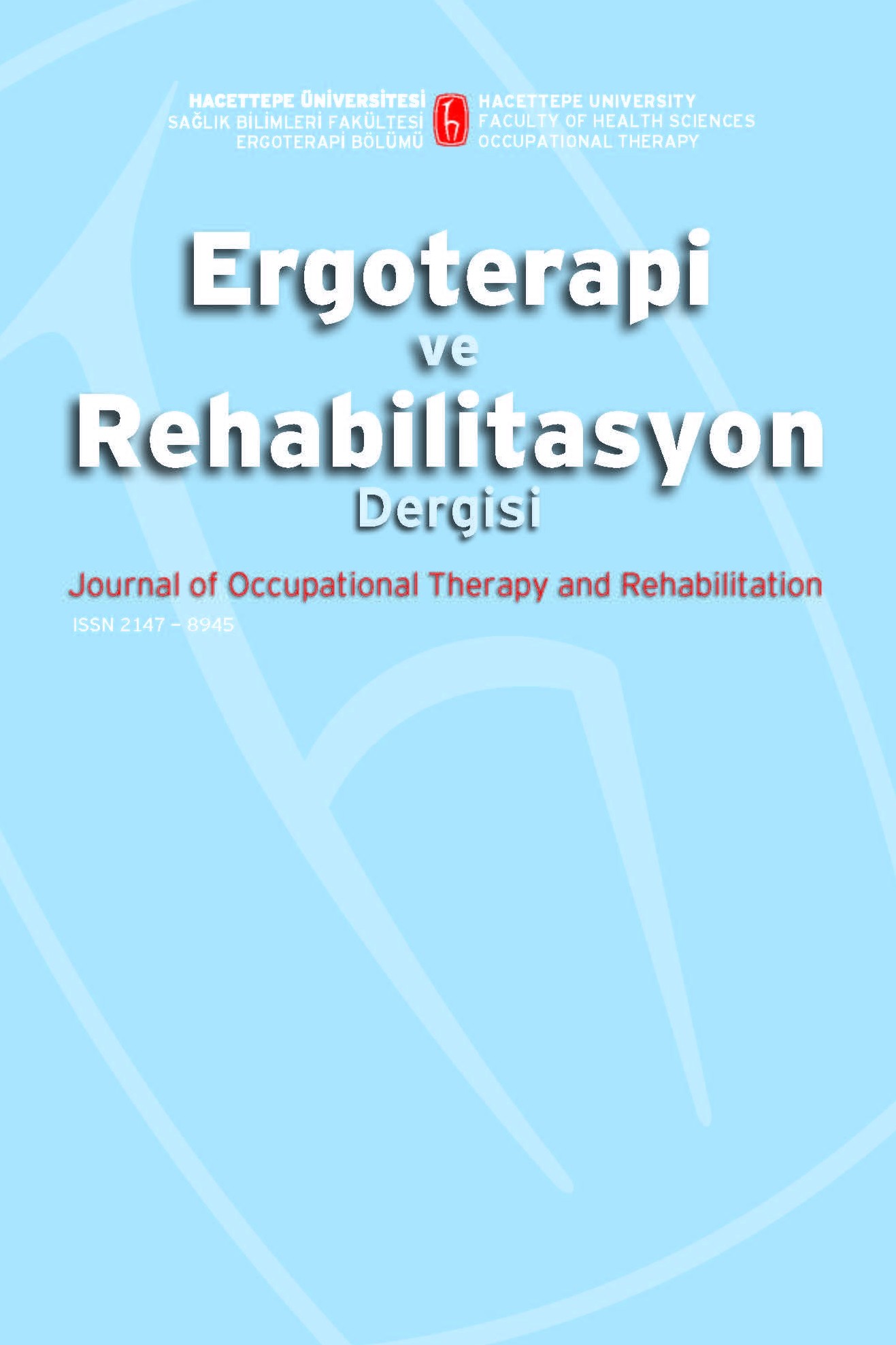Is It Really Accessibility: A Qualitative Study About School Accessibility
Serebral palsi, Çevre tasarımı, Sosyal katılım, Niteleyici araştırma, Mimari erişilebilirlik
Is It Really Accessibility: A Qualitative Study About School Accessibility
Cerebral palsy, Environment design, Social participation, Qualitative research, Architectural accessibility,
___
- Anaby, D., Hand, C., Bradley, L., DiRezze, B., Forhan, M., DiGiacomo, A., et al. (2013). The effect of the environment on participation of children and youth with disabilities: a scoping review. Disabil Rehabil, 35(19), 1589-1598.
- Anaby, D., Law, M., Coster, W., Bedell, G., Khetani, M., Avery, L., et al. (2014). The mediating role of the environment in explaining participation of children and youth with and without disabilities across home, school, and community. Arch Phys Med Rehabil, 95(5), 908-917.
- Di Marino, E., Tremblay, S., Khetani, M., & Anaby, D. (2018). The effect of child, family and environmental factors on the participation of young children with disabilities. Disabil Health J, 11(1), 36-42.
- Eliasson, A. C., Krumlinde-Sundholm, L., Rösblad, B., Beckung, E., Arner, M., Öhrvall, A. M., et al. (2006). The Manual Ability Classification System (MACS) for children with cerebral palsy: scale development and evidence of validity and reliability. Dev Med Child Neurol, 48(7), 549-554.
- Elo, S., & Kyngäs, H. (2008). The qualitative content analysis process. J Adv Nurs, 62(1), 107-115.
- Hidecker, M. J. C., Ho, N. T., Dodge, N., Hurvitz, E. A., Slaughter, J., Workinger, M. S., et al. (2012). Inter‐relationships of functional status in cerebral palsy: analyzing gross motor function, manual ability, and communication function classification systems in children. Dev Med Child Neurol, 54(8), 737-742.
- Hidecker, M. J. C., Paneth, N., Rosenbaum, P. L., Kent, R. D., Lillie, J., Eulenberg, J. B., et al. (2011). Developing and validating the Communication Function Classification System for individuals with cerebral palsy. Dev Med Child Neurol, 53(8), 704-710.
- King, G., Lawm, M., King, S., Rosenbaum, P., Kertoy, M. K., & Young, N. L. (2003). A conceptual model of the factors affecting the recreation and leisure participation of children with disabilities. Phys Occup Ther Pediatr, 23(1), 63-90.
- Larson, R. W. (2000). Toward a psychology of positive youth development. Am Psychol, 55(1), 170.
- Larson, R. W., & Verma, S. (1999). How children and adolescents spend time across the world: work, play, and developmental opportunities. Psychol Bull, 125(6), 701.
- Lauterpacht, H. (1948). The Universal Declaration of Human Rights. Brit. YB Int'l L., 25, 354.
- Law, M., Finkelman, S., Hurley, P., Rosenbaum, P., King, S., King, G., et al. (2004). Participation of children with physical disabilities: relationships with diagnosis, physical function, and demographic variables. Scand J Occup Ther, 11(4), 156-162.
- Law, M., Haight, M., Milroy, B., Willms, D., Stewart, D., & Rosenbaum, P. (1999). Environmental factors affecting the occupations of children with physical disabilities. Journal of occupational science, 6(3), 102-110.
- Lawlor, K., Mihaylov, S., Welsh, B., Jarvis, S., & Colver, A. (2006). A qualitative study of the physical, social and attitudinal environments influencing the participation of children with cerebral palsy in northeast England. Pediatric Rehabilitation, 9(3), 219-228.
- Lenker, J., & Perez, B. (2014). The role of occupational therapists in universal design research. Occupational Therapy Now, 16(5), 13.
- Özhancı, E., Aklıbaşında, M., & Tırnakçı, A. (2018). The disability standards and unimpeded design at Nevşehir Haci Bektas Veli Unıversity Campus. Akademik Ziraat Dergisi, 7(1), 83-92.
- Rosenbaum, P., Palisano, R., Walter, S., Russell, D., Wood, E., & Galuppi, B. (1997). Gross motor function classification system (gmfcs). Dev Med Child Neurol, 39, 214-23.
- Tieman, B. L., Palisano, R. J., Gracely, E. J., & Rosenbaum, P. L. (2004). Gross motor capability and performance of mobility in children with cerebral palsy: a comparison across home, school, and outdoors/community settings. Physical Therapy, 84(5), 419-429.
- World Health Organization. (2011). World report on disability: World Health Organization.
- Žgur, E. (2012). School process role for children with cerebral palsy. East J Med, 17(4), 213-216.
- ISSN: 2147-8945
- Yayın Aralığı: Yılda 3 Sayı
- Başlangıç: 2013
- Yayıncı: Hacettepe Üniversitesi Sağlık Bilimleri Fakültesi
Gerçekten Erişilebilir Mi? Okul Erişilebilirliği Hakkında Nitel Bir Çalışma
Sinem KARS, Hülya KAYIHAN, Meral HURİ, Gonca BUMİN
Berkan TORPİL, Onur ALTUNTAŞ, Mine UYANIK
Turkish Adaptation of ACTIVLIM Questionnaire in Neuromuscular Diseases by Rasch Analysiz
Muhammed KILINÇ, Çiğdem ÖKSÜZ, Derya GÖKMEN, İpek GÜRBÜZ, Cevher DEMİRCİ, Hatice ABAOĞLU, Sibel AKSU YILDIRIM, Öznur TUNCA YILMAZ
Levent SENNAROĞLU, Hülya KAYIHAN, Songül AKSOY, Merve Özbal BATUK
Özge DEMİREL, Şeyda TOPRAK ÇELENAY
Toplumsal Katılım ve Ergoterapi
Otizmin Basılı Medyada Temsili: Ulusal Eylem Planından Sonraki Sürecin İncelenmesi
Ruhsal Hastalıklarda Gevşeme Eğitiminin Ağrı, Yorgunluk Ve Uyku Üzerine Etkisinin İncelenmesi
Zeynep KOLİT, Gamze EKİCİ, A.elif ANIL YAĞCIOĞLU
Investigation of Factors Affecting Neuromotor Behavior in Premature Neonates
